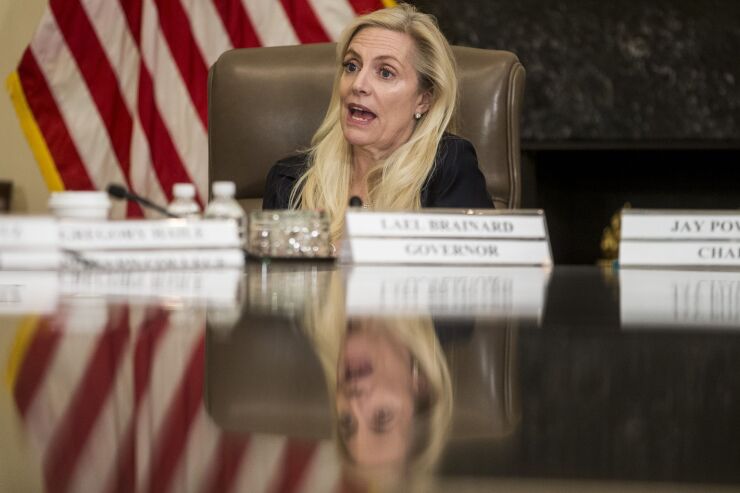The Federal Reserve wants more data about the credit banks are extending to unregulated nonbank financial institutions.
In its
The report does not call for changes to supervision or regulatory policy at the Fed, but it notes that monitoring the sector "could be enhanced with more comprehensive and timely data."
In recent years, the Fed has sought more data from banks about the nonbank financial institutions, or NBFIs, to which they lend, but gaps still remain. The Fed could continue to enhance these supervisory practices informally, but some policy specialists would like to see it go further.

Jeremy Kress, a business law professor at the University of Michigan and former Fed lawyer, said there should be capital requirements specifically for banks that lend to NBFIs as well as great regulation for those groups.
Kress, like other policy experts and economists, describes the growth of the NBFI sector as a direct response to the Dodd-Frank Act of 2010, which prohibited banks from engaging in many types of risky lending. Now, nonbanks are providing those loans instead, albeit with financing from banks. Kress said this arrangement undermines the efforts to insulate the banking system from risky behavior.
"If nonbank financial institutions experience distress, that distress could very easily transmit to the regulated banking sector by virtue of these interconnections between banks and nonbanks," he said. "The steady and rapid increase in bank lending to nonbank financial institutions is something that we should be worried about from a banking perspective."
Banks have extended nearly $2 trillion of credit to NBFIs as of the second quarter of this year, according to the report, up from roughly $1.7 trillion a year ago. This activity has increased rapidly in recent years and has outpaced broader bank lending, with NBFI lending growing at more than double the rate of nonfinancial lending during the past year.
Overall, leverage among borrowers of bank commercial and industrial loans has fallen during the past year on the back of tighter lending standards, the Fed's financial stability report notes. NBFIs, meanwhile, are known to carry high leverage ratios, and the opacity around their industries make it difficult to say precisely how indebted they are.
Fed Vice Chair Lael Brainard said given the numerous pressures on financial markets today, it is important that regulators be aware of all possible threats to the financial system.
"Today's environment of rapid synchronous global monetary policy tightening, elevated inflation, and high uncertainty associated with the pandemic and the war raises the risk that a shock could lead to the amplification of vulnerabilities — for instance due to strained liquidity in core financial markets or hidden leverage," Brainard said in a statement that accompanied the report.
Private-equity firms, business development companies and credit funds saw the biggest uptick in bank credit commitments, cumulatively seeing their allocations rise by around 25% year over year, according to the Fed's report. Special-purpose entities, collateralized loan obligations and asset-backed securities also saw a large uptick in bank funding, as did real estate lenders.
The largest category of borrowers in the Fed's report were those categorized as "other," cumulatively accounting for nearly $500 billion of bank credit. This category consists of a wide variety of private niche lenders that do not fall into the other broadly defined categories.
Across the board, the NBFIs in the Fed's report use credit facilities from banks to help finance their various business activities. Terms related to these facilities vary, but they tend to be floating-rate products. While some of these borrowers provide services once dominated by banks, such as originating mortgages or lending to small businesses, others engage in activities aimed at delivering financial returns to investors.
Some economists say the Fed helped facilitate the growth of these industries through easy monetary policy. With government bonds yielding next to nothing, investors were encouraged to move into riskier investments and investment structures, said Derek Tang, co-founder of the Washington-based research firm Monetary Policy Analytics.
Now that the Fed is tightening monetary policy, the risk associated with private equity and other structures is less appealing, Tang said, which could lead to a sudden exodus of investors at a time when many assets are depreciating in value and broader instability is on the rise.
Such a rapid shift could put a host of lenders to the test simultaneously — and too many of them might not pass.
"In an ideal world, this [market] would self-correct because, as banks that didn't do their due-diligence process well would get shut out of the business, because they're not making good decisions," Tang said. "In the meantime, there is an adjustment process, and that adjustment could be a big source of instability."






